
Pemberton is a town in the South West region of Western Australia, named after original settler Pemberton Walcott.

Manjimup is a town in Western Australia, 307 kilometres (191 mi) south of the state capital, Perth. The town of Manjimup is a regional centre for the largest shire in the South West region of Western Australia. At the 2016 census, Manjimup had a population of 4,349.

Kirup, originally named Upper Capel, then Kirupp, is situated between Donnybrook and Balingup on the South Western Highway, 228 kilometres (142 mi) south of Perth, Western Australia in the upper reaches of the Capel River valley.

Jarrahdale is a small historic town located 45 km south-east of Perth, Western Australia in the Darling Range. The name is derived from its situation in a jarrah forest. Established in the late 1800s as the state's first major timber milling operation, it played a key role in the development of Western Australia through the exportation of jarrah around the world. At the 2016 census, Jarrahdale had a population of 1,192. Since 2001, the historic precinct has been managed by the state's National Trust organisation alongside private residential and tourism-oriented developments.
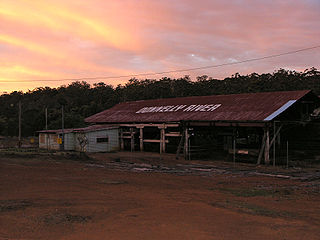
Donnelly River Village is a former timber mill town and present-day holiday village in the Shire of Nannup, in the South West region of Western Australia. The Village is located at a point between Nannup, Bridgetown and Manjimup on the Donnelly River, a small, seasonal river at this point, which flows into the Southern Ocean at 34°29′02.4″S115°40′27.8″E. The name also applies to a winery downstream on the Vasse Highway and the township's cottages are sometimes confused with cottages built on the lower reaches of the Donnelly River at 34°28′56″S115°41′00″E.

The Shire of Manjimup is a local government area in the South West region of Western Australia, about 320 kilometres (200 mi) south of the state capital, Perth. The Shire covers an area of 7,027 square kilometres (2,713 sq mi), and its seat of government is the town of Manjimup.
Fonty's Pool is a historic freshwater swimming pool near Manjimup, Western Australia. It is registered with the National Trust of Australia as an area of heritage significance.

The network of railway lines in Western Australia associated with the timber and firewood industries is as old as the mainline railway system of the former Western Australian Government Railways system.
The Lower South West Football League is a country Australian rules football league incorporating teams from towns located within the South West and Great Southern regions of Western Australia.
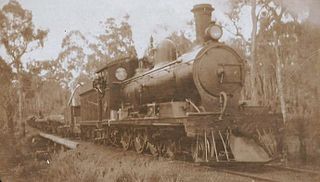
The WAGR J class was a three-member class of 4-6-0 steam locomotives operated by the Western Australian Government Railways (WAGR) between 1892 and 1924 before seeing further use with the State Saw Mills until the early 1930s.
Rappville is a small village in northern New South Wales, Australia. At the 2016 census, Rappville recorded a population of 169 people.
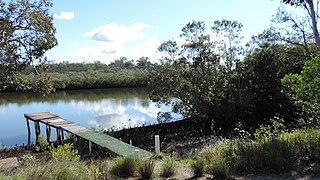
Coochin Creek is a coastal locality in the south of the Sunshine Coast Region, Queensland, Australia. The locality is named for the creek which flows through it.

Lahey's Canungra Sawmill is a heritage-listed former sawmill at 10-26 Finch Road, Canungra, Scenic Rim Region, Queensland, Australia. It was built in 1884. It was added to the Queensland Heritage Register on 6 March 2009.
Norman Houghton is a historian and archivist in Geelong, Victoria, who has published more than 40 books, many focusing on timber tramways and sawmills of the Otway and Wombat Forests of Western Victoria, Australia. Most of his works have been self-published, while he has provided numerous articles to the newsletter and journal of the Light Railway Research Society of Australia.

The Cooloola Tramway is a heritage-listed tramway at Great Sandy National Park, Cooloola Recreation Area, Cooloola, Gympie Region, Queensland, Australia. In the 1870s it was known as the Kaloola Railway. It is also known as Cooloola Railway, SEQ-5N 22, Pettigrew's Railway, and Pettigrew's Tramway. It was added to the Queensland Heritage Register on 12 July 2013.
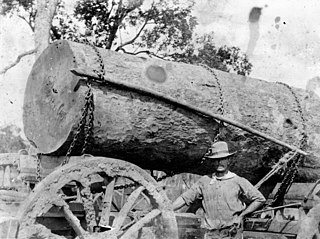
Barakula is a rural locality in the Western Downs Region, Queensland, Australia. In the 2021 census, Barakula had "no people or a very low population".
The Wooleybah Sawmill and Settlement is a heritage-listed former small settlement and sawmill at Old Wooleybah Road, Kenebri, Warrumbungle Shire, New South Wales, Australia. It was built from 1935 by the Underwood family. It is also known as Wooleybah Dead Man's Waterhole. The property is owned by Forestry Commission of NSW, an agency of the Government of New South Wales. It was added to the New South Wales State Heritage Register on 17 December 2010.
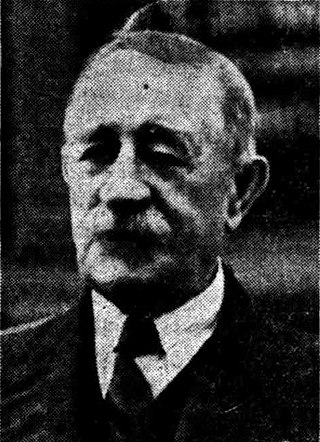
Robert Bunning was an English-born Western Australian businessman involved in the construction, timber, and sawmill industries. He co-founded with his younger brother Arthur (1863-1929) the company Bunning Bros, the predecessor to the modern-day retailer Bunnings Warehouse.

The Northcliffe Branch, also known as the Northcliffe Section or Picton to Northcliffe Line, is the railway route between Picton and Northcliffe in Western Australia.

The Boyup Brook-Cranbrook Railway, was an authorised but never constructed railway line in the South West and Great Southern regions of Western Australia. The railway line was to connect Boyup Brook, located on the Donnybrook–Katanning railway, with Cranbrook on the Great Southern Railway.

















